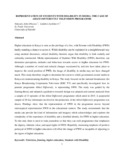| dc.description.abstract | Higher education in Kenya is seen as the privilege of a few, with Persons with Disability (PWD) hardly standing a chance to access it. While disability can be explained in a straightforward way using medical discourses, critical disability theorists argue that disability is both socially and culturally constructed. Media representation of Students With Disability (SWD), therefore, can determine perceptions, attitudes and behaviour towards access to higher education for PWD. Although a number of social and cultural changes occasioned by activists have taken place to improve the social position of PWD, the image of disability in media may not have changed much. This study therefore sought to determine the extent to which government owned media in Kenya are mainstreaming disability in Kenya. The study focused on the national broadcaster, the Kenya Broadcasting Corporation Television (KBC TV) and specifically investigated how its premier programme Abled Differently, is representing SWD. The study was guided by the framing theory and adopted a qualitative research design was adopted and content analysed from a sample of 13 episodes of the Abled Differently programme which aired in 2015. A purposeful sample of 20 key informants involved in the production of the Abled Differently programme was drawn. Findings show that the representation of SWD in the programme moves beyond stereotypical representation SWD in the educational context. The study recommends that the media can provide the kind of information and imagery which acknowledges and explores the complexity of the experience of disability and a disabled identity for SWD in higher education. To this end, there is need to train journalists so that they can craft programmes that emphasize the dignity, inherent value, and equal rights of SWD. Hopefully, increasing emphasis of positive portrayal of SWD in higher education will offset the image of PWD as incapable of adjusting to the rigors of higher education. | en_US |

